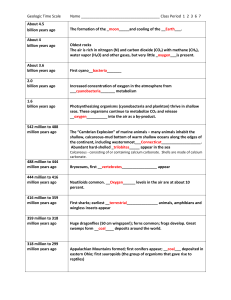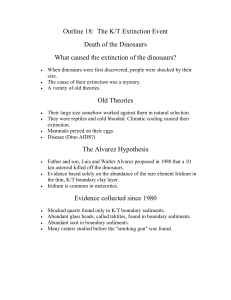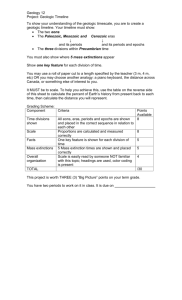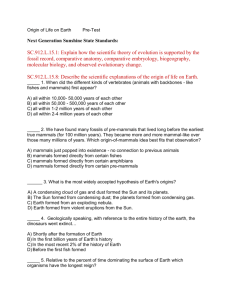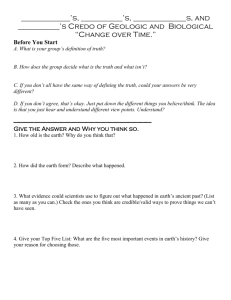Document 11718452
advertisement
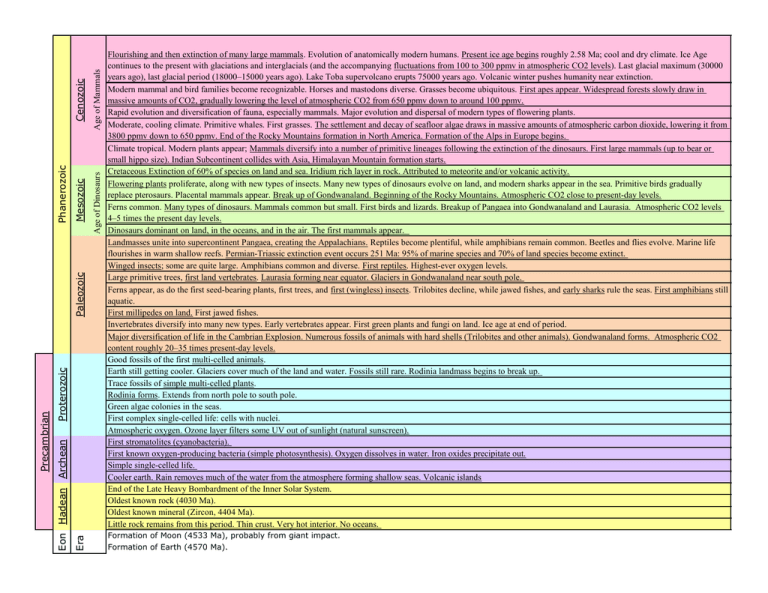
Cenozoic Age of Mammals Mesozoic Age of Dinosaurs Paleozoic Phanerozoic Era Proterozoic Eon Hadean Archean Precambrian Flourishing and then extinction of many large mammals. Evolution of anatomically modern humans. Present ice age begins roughly 2.58 Ma; cool and dry climate. Ice Age continues to the present with glaciations and interglacials (and the accompanying fluctuations from 100 to 300 ppmv in atmospheric CO2 levels). Last glacial maximum (30000 years ago), last glacial period (18000–15000 years ago). Lake Toba supervolcano erupts 75000 years ago. Volcanic winter pushes humanity near extinction. Modern mammal and bird families become recognizable. Horses and mastodons diverse. Grasses become ubiquitous. First apes appear. Widespread forests slowly draw in massive amounts of CO2, gradually lowering the level of atmospheric CO2 from 650 ppmv down to around 100 ppmv. Rapid evolution and diversification of fauna, especially mammals. Major evolution and dispersal of modern types of flowering plants. Moderate, cooling climate. Primitive whales. First grasses. The settlement and decay of seafloor algae draws in massive amounts of atmospheric carbon dioxide, lowering it from 3800 ppmv down to 650 ppmv. End of the Rocky Mountains formation in North America. Formation of the Alps in Europe begins. Climate tropical. Modern plants appear; Mammals diversify into a number of primitive lineages following the extinction of the dinosaurs. First large mammals (up to bear or small hippo size). Indian Subcontinent collides with Asia, Himalayan Mountain formation starts. Cretaceous Extinction of 60% of species on land and sea. Iridium rich layer in rock. Attributed to meteorite and/or volcanic activity. Flowering plants proliferate, along with new types of insects. Many new types of dinosaurs evolve on land, and modern sharks appear in the sea. Primitive birds gradually replace pterosaurs. Placental mammals appear. Break up of Gondwanaland. Beginning of the Rocky Mountains. Atmospheric CO2 close to present-day levels. Ferns common. Many types of dinosaurs. Mammals common but small. First birds and lizards. Breakup of Pangaea into Gondwanaland and Laurasia. Atmospheric CO2 levels 4–5 times the present day levels. Dinosaurs dominant on land, in the oceans, and in the air. The first mammals appear. Landmasses unite into supercontinent Pangaea, creating the Appalachians. Reptiles become plentiful, while amphibians remain common. Beetles and flies evolve. Marine life flourishes in warm shallow reefs. Permian-Triassic extinction event occurs 251 Ma: 95% of marine species and 70% of land species become extinct. Winged insects; some are quite large. Amphibians common and diverse. First reptiles. Highest-ever oxygen levels. Large primitive trees, first land vertebrates. Laurasia forming near equator. Glaciers in Gondwanaland near south pole. Ferns appear, as do the first seed-bearing plants, first trees, and first (wingless) insects. Trilobites decline, while jawed fishes, and early sharks rule the seas. First amphibians still aquatic. First millipedes on land. First jawed fishes. Invertebrates diversify into many new types. Early vertebrates appear. First green plants and fungi on land. Ice age at end of period. Major diversification of life in the Cambrian Explosion. Numerous fossils of animals with hard shells (Trilobites and other animals). Gondwanaland forms. Atmospheric CO2 content roughly 20–35 times present-day levels. Good fossils of the first multi-celled animals. Earth still getting cooler. Glaciers cover much of the land and water. Fossils still rare. Rodinia landmass begins to break up. Trace fossils of simple multi-celled plants. Rodinia forms. Extends from north pole to south pole. Green algae colonies in the seas. First complex single-celled life: cells with nuclei. Atmospheric oxygen. Ozone layer filters some UV out of sunlight (natural sunscreen). First stromatolites (cyanobacteria). First known oxygen-producing bacteria (simple photosynthesis). Oxygen dissolves in water. Iron oxides precipitate out. Simple single-celled life. Cooler earth. Rain removes much of the water from the atmosphere forming shallow seas. Volcanic islands End of the Late Heavy Bombardment of the Inner Solar System. Oldest known rock (4030 Ma). Oldest known mineral (Zircon, 4404 Ma). Little rock remains from this period. Thin crust. Very hot interior. No oceans. Formation of Moon (4533 Ma), probably from giant impact. Formation of Earth (4570 Ma).

